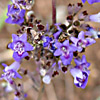Vitex agnus-castus (Lilac Chaste Tree) is a branched riparian shrub. It reaches a height of 2-3 m. It grows near ever-flowing streams and also along streams that flow in the winter only.
Lilac Chaste Tree is easily recognizable by its digitate leaves. The leaf is palmate, and is divided into 5-7 narrow and long separate lanceolate lobes which emerge from a single point. The leaves are alternate. The leaf is felty on the lower side and dark green on the upper side.
The tree is winter deciduous, at that time it is recognizable by the racemes of its dry fruits.
Lilac Chaste Tree blooms in the summer, from June to September, and serves as an important honey plant during this dry season. The corolla is two-lipped, purple, and 8 mm long. The corolla protrudes out of a bell-shaped calyx and the 4 stamens protrude out of the corolla. The inflorescence is beautiful, and is one of the reasons why this plant is used in ornamental gardens. The fruit is a small spherical drupe, dry and fragrant. Its branches are used for weaving baskets and its fruits are used as a spice.
In the past, a substance was extracted from the seeds, which was believed to reduce sexual attraction.
It grows in suitable habits in all parts of Israel, except for the extreme desert.
Lilac Chaste Tree shares the landscape with Nerium oleander (Oleander). Mainly Lilac Chaste Tree grows in Nahal Kziv, and very little Oleander. Oleander thrives in all its glory in Nahal Betzet, where very few Lilac Chaste Trees grow. Another species, Vitex pseudo-negundo, is very similar to it, somewhat taller, grows near water only in the Kinneret Valley and in the Hula Valley, and it is difficult to distinguish between the two.
In folk medicine it is used to treat headaches, joint pains, stomach aches and poisonings. It is also good for strengthening the hair roots and for improving vision.
The genus includes 250 species. In Israel there are 2 species.
Written by Mike Livne






